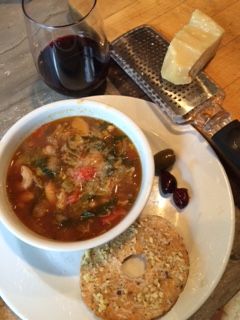
Yes, it is an invasive plant and garlic mustard grows all over the place throughout the country–however if you have it, you might as well eat it. It is a nutritious leafy green, a member of the mustard family, that tastes like a garlic-flavored green and it is yours for the harvesting. The smell is green and suggestive of garlic, while the flavor is pungent, slightly bitter and definitely garliclike. It is one of the most nutritious of all of the leafy greens containing vitamins C and E, beta carotene, calcium, iron, manganese, omega-3s and zinc.
Right now, depending on where you live, garlic mustard has flowered (in my zone 7 garden)–although in northern climes–you can probably still gather it. I’ve been eating the leaves since it appeared in the garden–using small ones in salads and soups. As it grows taller and gets older, the leaves get bigger and a bit more chewy. I still use larger leaves, torn up in salads, however I find them better cooked or pounded into in a salsa verde. Once the plant sends up its white flowers, which can be used as a garnish on soups, pasta, pizza, grains, egg dishes or salad, the leaves get a little more bitter though still edible.
I like the leaves wilted with other potherbs and simply dressed with olive oil, fresh minced or crushed garlic, sea salt and freshly ground pepper; sometimes a few red pepper flakes. Although, you don’t have to use garlic with garlic mustard. Chop it up and use it anywhere you might use spinach or kale–in the soup pot, with beans and grains, in casseroles, and it is great in egg dishes.
I especially like it used with other wild greens in my wild greens salsa verde; try nettles, bee balm, dandelion greens, wild sorrel or purslane. Or use garden-grown greens like spinach, arugula, parsley, sorrel or basil. /item/63498/salsa-verde-with-wild-weeds
It is best to cut or break off the flower stems (eat those edible blooms) before they form seeds. The plant is a biennial and stays fairly small in its first year of growth, however in the second year it sends up a bloom stalk that has thousands of seeds, which will drop wherever it is growing. Since the plant is considered an invasive in the U.S. (it is eaten throughout Europe), it is best not to let it go to seed. I still have plenty of volunteers even though I pull the plants up from the roots when I harvest them.
In some places in Maryland, the garlic mustard is taking over the woodland undergrowth and not allowing natives to survive. In his book Edible Wild Plants, forager John Kallas, describes the invasive phenomenon of garlic mustard, “… Their roots exude chemicals that kill beneficial mycorrhiza in the soil (underground fungi that are good for many native plants) and inhibit other plants from germinating. The result is whole areas overrun with garlic mustard plants.”
So, don’t sow this seed, harvest garlic mustard and help eradicate it–and be sure that you have correctly identified the plant before putting it on your plate.






















Comments
Log in or create an account to post a comment.
Sign up Log in